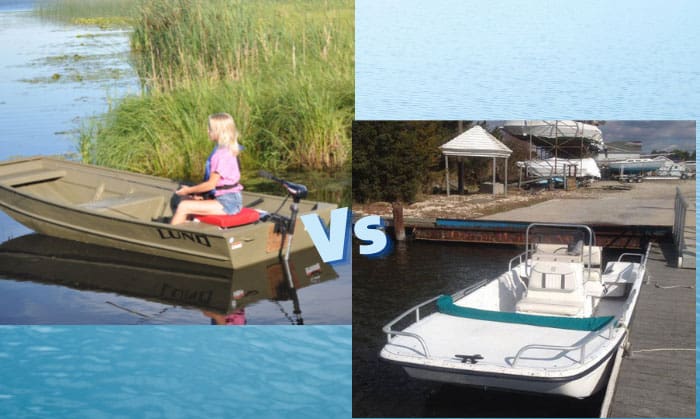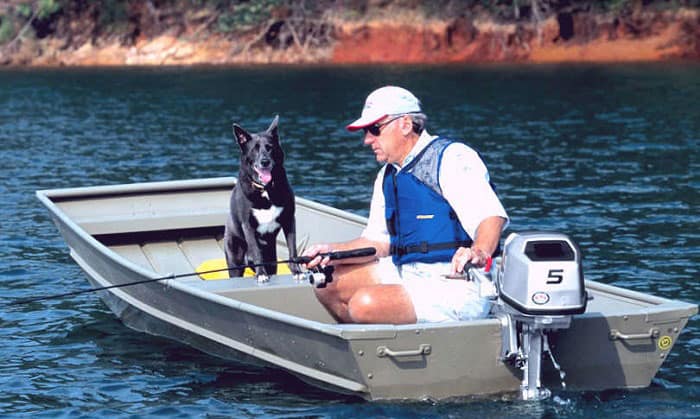Are you ready to take your fishing to the next level but cannot decide which between a skiff vs Jon boat you should get? I understand the confusion because these two watercraft can look uncannily similar to the newbie boat owner. Both are excellent for freshwater fishing.
However, skiffs and Jon boats have different design philosophies that define their performance in the water. Knowing these differences should help you decide which boat to get for your fishing and other water-related adventures. This article helps you do just that.
Table of Contents
Overview of Jon Boats and Skiffs
Skiffs and Jon boats are excellent small watercraft for fishing in shallow waters because of their hull design. You might have seen these two boats in the same fishing area. Let us have an overview of these two vessels.
1. Skiffs
The term ‘skiff’ is quite vague because it includes different boat varieties. It is not unusual for people to confuse Jon boats for skiffs because of skiffs’ broad classification.
What is a skiff boat used for? Skiff boats are perfect for fishing, relying on their spacious deck design to accommodate more fishing gear and prized catches. They have an open deck, a flat stern, and a pointed bow. Some skiffs have flat bottoms. Their design makes them stable fishing platforms in calm waters.
However, the spacious deck also makes skiffs ideal for transporting people and goods. Unfortunately, so do Jon boats, making differentiation more challenging.
Traditionally, skiffs come with sails or oars. However, modern technology allows builders to put a console right in the boat’s center. Skiffs’ engines are also more powerful than those of Jon boats. Skiff boats can move along shallow waterways, using a pole for guidance and propulsion.
2. Jon Boats
A Jon boat is almost similar to a skiff, except for a shallower draft and a lower freeboard. This vessel is often lightweight and easy to maintain. Its design allows a Jon boat to traverse very shallow waters, as shallow as only a few inches.
You can row, punt, or paddle a Jon boat on almost any body of water. Most boat owners prefer fitting it with an outboard motor and a tiller.
A Jon boat’s flat-bottomed hull facilitates different uses, such as transportation and hunting. After all, its origins date back to American pioneers who explored the lands and waters of the New World.
I have friends who love standing on a Jon boat’s stable flat bottom to hunt game fowls in the water. Jon boats are perfect for ferrying people and goods across and along rivers and shallow waterways.
Hence, it would be safe to assume that a Jon boat is more versatile than a fishing skiff. It would be best to get a skiff if you can see yourself doing nothing else but fish whenever you have the chance. On the other hand, a Jon boat is a better option if you plan on taking your family with you.
What Materials Do Manufacturers Use in Building Jon Boats and Skiffs?
Contemporary manufacturers use different hull materials to build boats, including skiffs and Jon boats. Historically, boats are wooden with a water-repellent substance. Today, companies use steel, aluminum, fiber-reinforced plastic (or fiberglass), and polyethylene.
Modern skiffs and Jon boats typically come in fiberglass, wood, or aluminum.
Most boat manufacturers use fiberglass because it is light, corrosion-proof, durable, watertight, strong, and allows speedier navigation across waters. The only problem is its cost, making a fiberglass flat bottom boat more expensive than skiffs or Jon boats with wood.
Aluminum is extra-lightweight, making boats run faster in water and ensuring more convenient transportation. You can haul an aluminum boat with relative ease, enabling you to enjoy more water adventures anywhere.
Aluminum’s strength is exceptional, allowing boaters to ride their vessels over sharp banks and rocky bottoms without denting their watercraft. Its flexibility enables aluminum to absorb impact forces better than fiberglass.
Most people think Jon boats feature aluminum hulls, while skiffs have fiberglass materials. While this notion is almost accurate, it would be best to understand that both boats can have aluminum, fiberglass, and wood constructions.
The material differences between a Jon boat vs skiff can help you choose between them. Go for aluminum if you want a rugged yet lightweight vessel for various applications. A fiberglass boat is a wiser choice if you like a more stable ride on rough waters.
What Are the Hull Design Differences between a Skiff and a Jon Boat?
We now know that Jon boats are more versatile than skiffs. And although both vessels can come in different materials, skiffs often feature a fiberglass hull, while Jon boats have aluminum. Let us now look at their hull design differences.
1. Jon Boat Hull Design
Jon boats come in two hull designs: flat and mod-V. The hulls perform differently, depending on water conditions.
- Flat Bottom
Most Jon boats have a flat bottom, adhering to traditional design principles. These water vessels are excellent in navigating inland waters. The design also guarantees exceptional stability, but only in calm waters. It is the perfect platform for fishing and hunting.
Unfortunately, a Jon boat often has a square bow and a flat transom. This design prevents the Jon boat flats boat from deflecting waves. The flat bottom also makes the boat unstable in rough waters.
- Mod-V
Many boaters want a Jon boat they can use in choppy inland waters. The answer? A Jon boat with a flat bottom and a pointed bow – the mod-V Jon boat.
This V front flat bottom boat retains the traditional Jon boat’s stability in calm waters. However, the v-shaped bow empowers the boat to slice through rough waters, deflecting the waves and minimizing roll tendencies.
Most modern boaters consider the mod-V Jon boat superior to traditional Jons. They can fish and transport people and goods in choppy waters without the fear of overturning.
Unfortunately, the hull design change makes this Jon boat type larger, heavier, and more expensive. You might want to consider these attributes when choosing between a Mod-V and a square-bow Jon boat.
2. Skiff Hull Design
A skiff boat’s hull design is almost similar to a Jon boat’s. There are two types of skiffs:
- Flat Bottom
A flat bottom skiff is perfect for navigating inlets, lakes, rivers, and other inland waterways. Saltwater skiffs have square sterns and sharp bows. You can raise the outboard motor from the water if you traverse shallow waters. You can then use a pole to propel and maneuver the boat.
However, the skiff boat’s deep draft design makes it unsuitable for navigating over very shallow waters. The boat’s bottom can scrape the ground below the water’s surface, increasing the risk of running aground.
- Semi-V
Like a Mod-V Jon boat, a skiff with a semi-V bow is perfect for navigating choppy waters. It often has a livewell to hold fish. Unfortunately, skiff manufacturers often design the hull with deeper drafts than Jon boats. Hence, these watercraft are not suitable for very shallow waters.
The semi-V skiff boat is the watercraft of choice for seasoned boaters fishing in deep rivers, bays, and lakes. Because of their size and construction, many semi-V skiffs are also perfect for fishing off coastal regions.
Which Is Safer, Jon Boat or Skiff?
Most US boaters prefer a Jon boat to skiff boats because of its versatility.
However, skiffs have flat bottoms, stabilizing them on calm waters. Their pointed bows are always perfect for slicing through choppy waters. And since skiffs are typically larger and heavier than Jon boats, they can handle bad weather and rough waters better than Jon boats.
I must reiterate that Jon boats often come in aluminum, making them more lightweight compared to skiffs. Strong winds and turbulent waves can easily flip a Jon boat.
I think the crucial question here is “who will be piloting the watercraft?” I prefer joining an experienced boater on a tiny Jon boat than going on a large skiff at the hands of a novice pilot.
Conclusion
Here are the crucial takeaways when deciding between skiff vs Jon boat.
- Jon boats can traverse through very shallow waters up to a few inches deep; skiff boats cannot.
- Jon boats are lighter than skiff boats, allowing users to move them more easily.
- Skiffs are safer in rough waters and bad weather than Jon boats, although the pilot’s experience plays a crucial role.
- Jon boats are more affordable and smaller than skiff boats.
We hope the summary helped you pick your new boat. Please share this article with your friends, who might be curious about the differences between skiffs and Jon boats.

Ten years of enjoying countless trips on boats never made me love them any less! So I am here to put all those experiences into good use for other boaters who want to have a safe and fun trip with their friends and families.



